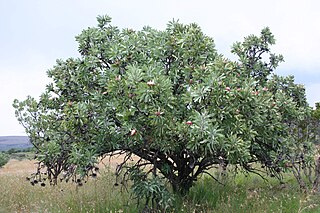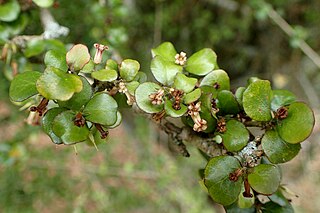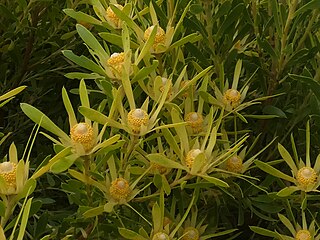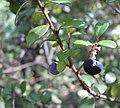
Lagerstroemia, commonly known as crape myrtle, is a genus of around 50 species of deciduous and evergreen trees and shrubs native to the Indian subcontinent, southeast Asia, northern Australia, and other parts of Oceania, cultivated in warmer climates around the world. It is a member of the family Lythraceae, which is also known as the loosestrife family. The genus is named after Swedish merchant Magnus von Lagerström, a director of the Swedish East India Company, who supplied Carl Linnaeus with plants he collected. These flowering trees are beautifully colored and are often planted both privately and commercially as ornamentals.

Salix cinerea is a species of willow native to Europe and western Asia.

Spirostachys africana is a medium-sized deciduous tree with a straight, clear trunk, occurring in the warmer parts of Southern Africa. Its wood is known as tamboti, tambotie, tambootie or tambuti.

Tecoma capensis, the Cape honeysuckle, is a species of flowering plant in the family Bignoniaceae, native to southern Africa. Despite its common name, it is not closely related to the true honeysuckle.

Protea caffra, native to South Africa, is a small tree or shrub which occurs in open or wooded grassland, usually on rocky ridges. Its leaves are leathery and hairless. The flower head is solitary or in clusters of 3 or 4 with the involucral bracts a pale red, pink or cream colour. The fruit is a densely hairy nut. The species is highly variable and has several subspecies.

Pittosporum obcordatum, commonly called heart-leaved kohuhu or heart-leaved kohukohu or kohukohu, is a species of plant in the Pittosporaceae family. It is endemic to New Zealand, and exists both in North Island and South Island.

Myrsine australis, commonly known as māpou, red matipo, māpau, tīpau, and mataira, is a species of shrub within the family Myrsinaceae. It is endemic to New Zealand, found throughout both the mainland and offshore islands.

Celtis africana, the white stinkwood, is a deciduous tree in the family Cannabaceae. Its habit ranges from a tall tree in forest to a medium-sized tree in bushveld and open country, and a shrub on rocky soil. It occurs in Yemen and over large parts of Africa south of the Sahara. It is a common tree in the south and east of southern Africa, where the odour given off by freshly-cut green timber is similar to that of Ocotea bullata or Black Stinkwood.

Diospyros whyteana is a small African tree of the ebony family. Bearing dark green, strikingly glossy leaves and creamy fragrant flowers, it is increasingly cultivated in Southern African gardens as an attractive and strong ornamental tree. It can attain a height of up to 6 m.

Rapanea melanophloeos, commonly known as Cape beech, Kaapse boekenhout or isiCalabi, is a dense, graceful, evergreen tree that is native to the afromontane forests of Southern Africa. Outside forests they are also commonly encountered along stream banks and in gullies.

Ilex mitis is a tall, dense, evergreen tree that is indigenous to Southern Africa. It makes an excellent fast-growing hedge for gardens - growing tall, straight and dense.

Acer palmatum, commonly known as Japanese maple, palmate maple, or smooth Japanese maple (Japanese: irohamomiji, イロハモミジ, or momiji,, is a species of woody plant native to Japan, Korea, China, eastern Mongolia, and southeast Russia. Many different cultivars of this maple have been selected and they are grown worldwide for their large variety of attractive forms, leaf shapes, and spectacular colors.

Ts'ehlanyane National Park is a National Park in Lesotho. It is located in the Maloti Mountains in Leribe District, and is part of the larger Maloti-Drakensberg Transfrontier Conservation Area. This Lesotho northern park protects a high-altitude, 2,600-metre (8,500 ft) patch of rugged wilderness, including one of Lesotho’s only stands of indigenous forest with a number of rare undergrowth plants that are unique to this woodland habitat.
A member of the family Magnoliaceae, Magnolia nana is an evergreen shrub that produces white or cream colored flowers. It can grow to be 2–3 ft (61–91 cm) in height and 2–3 ft (61–91 cm) in width. The Dwarf Magnolia is native to South East Asia, specifically Vietnam. It grows in most moderate climates, but cannot withstand dryness or drought. Magnolia nana grows best in well drained, partially alkaline soil, with exposure to partial sunlight.

Euclea crispa, commonly known as the blue guarri, is an Afrotropical plant species of the family Ebenaceae. The hardy and evergreen plants may form a dense stand of shrubs, or grow to tree size. It is widespread and common in the interior regions of southern Africa, and occurs northward to the tropics. Though some are present near the South African south and east coasts, they generally occur at middle to high altitudes. It is readily recognizable from its much-branched structure and dull bluish foliage colour. Those bearing lanceolate leaves may however resemble the Wild olive, another common species of the interior plateaus.

Leucadendron coniferum, also known at the dune conebush, is an evergreen, dioecious shrub or small tree of up to 4 m (13 ft) high, that has been assigned to the family Proteaceae. It has a whorl of conspicuous yellow leaves subtending the flowerheads. The flowers can be found in August and September. It grows in sandy soils near the coast of the Western Cape province of South Africa.

Mimetes stokoei, the mace pagoda, is an evergreen, upright, hardly branching, large shrub of 1–2 m high in the family Proteaceae. It has silvery, oval leaves of 5–8 cm (2.0–3.2 in) long and 2+1⁄2–4 cm (1.0–1.6 in) wide, with one large tooth supported by two smaller teeth near the tip, at an upward angle and somewhat overlapping each other. The inflorescences are set just below the growing tip, are cylinder-shaped, 10–12 cm (4–5 in) high, topped by a crest of small, more or less horizontal, pinkish-purple tinged leaves. It consists of several flower heads in the axils of golden leaves with a pinkish wash that form a hood shielding the underlying flower head. Each flower head contains eight to twelve individual flowers, with amber-colored styles topped by blackish purple pollen presenters and grey silky perianth lobes. It is endemic to the Fynbos ecoregion of South Africa, being confined to the Kogelberg mountain range. The mace pagoda was twice presumed extinct, but reappeared in its natural habitat from seed, after a wildfire several decades later.

Felicia dregei is an evergreen, glandular shrub of up to 11⁄2 m (5 ft) high, that is assigned to the daisy family. It has flat, finely felty, grayish green, narrowly elliptic to lance-shaped leaves of up to 4 cm long and 8 mm wide, with an entire margin or here and there with up to ten teeth. The flower heads have about ten violet ray florets, encircling many yellow disc florets. This species grows in the Northern Cape and Western Cape provinces of South Africa.

Mairia coriacea is a perennial plant assigned to the daisy family. It has broad, tough and leathery, evergreen leaves. These have a narrowed foot and an entire margin or a few shallow, irregular teeth. They grow in a rosette directly from the rootstock. The plant produces flower heads with one whorl of white to mauve ray florets around many yellow disc florets, with one or few on top of a dark reddish, woolly stalk. Flower heads appear after the overhead vegetation burnt down, often destroying the leaves in the process. It can be found in the southern mountains of South Africa's Western Cape province. It is called leather leaves in English.

Protea odorata is a small, sparsely branched, unisexual evergreen shrub that grows up to 1.5 metres tall. It has light green branches that turn brown with age and produce leaves that are upward or arched like leaves. The leaves are hairless and have a curved back and tips that can easily hurt the hand when touched. The leaves become black with age and the spines are pink or reddish in young years, but turn brown and brown with age.























